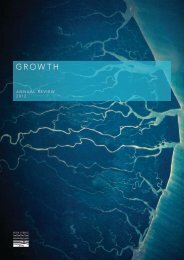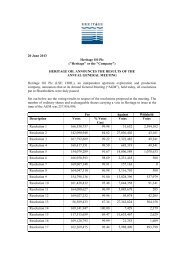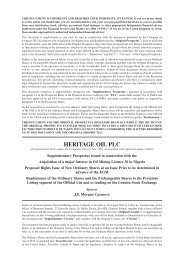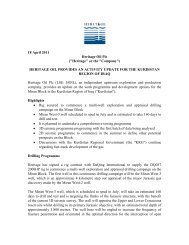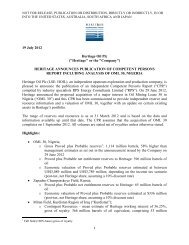Prospectus re Admission to the Official List - Heritage Oil
Prospectus re Admission to the Official List - Heritage Oil
Prospectus re Admission to the Official List - Heritage Oil
Create successful ePaper yourself
Turn your PDF publications into a flip-book with our unique Google optimized e-Paper software.
RPS Energy<strong>Heritage</strong> <strong>Oil</strong> – Competent Persons ReportAs discussed above <strong>the</strong> Mishrif-Mauddud <strong>re</strong>servoir thickness varies considerably over <strong>the</strong> field. Themajority of this variation occurs in <strong>the</strong> Mishrif Formation. The thicker isopachs <strong>re</strong>p<strong>re</strong>sent <strong>the</strong> platformcarbonates drilled at Henjam-1 and West Bukha-2 as opposed <strong>to</strong> <strong>the</strong> slope facies drilled at West Bukha-1and Khasab-1. These platform carbonates a<strong>re</strong> cleaner better <strong>re</strong>servoir facies and <strong>the</strong><strong>re</strong>fo<strong>re</strong> <strong>the</strong>ir extent hasbeen modelled when calculating GRV. Isochron maps have been used <strong>to</strong> determine <strong>the</strong> extent of this better<strong>re</strong>servoir facies in line with p<strong>re</strong>vious studies carried out by Indago and Novus. Gross rock volumes we<strong>re</strong>calculated from <strong>the</strong> Top Mishrif <strong>to</strong> Top Nahr Umr for <strong>the</strong> whole field. The GRV of <strong>the</strong> better Mishrif<strong>re</strong>servoir was calculated from <strong>the</strong> <strong>to</strong>p Mishrif <strong>to</strong> <strong>to</strong>p Mishrif 1 unit over <strong>the</strong> a<strong>re</strong>a interp<strong>re</strong>ted <strong>to</strong> be part of<strong>the</strong> platform above <strong>the</strong> fluid contact. The Mishrif 2 and 3 units GRV was <strong>the</strong>n <strong>re</strong>moved from <strong>the</strong> <strong>to</strong>tal fieldGRV so that separate <strong>re</strong>servoir parameters could be applied <strong>to</strong> both GRVs. These two separate cases we<strong>re</strong><strong>the</strong>n consolidated. For <strong>the</strong> Top Mishrif <strong>re</strong>servoir, a surface was calculated by isopaching 23 m down from<strong>the</strong> Top Ilam depth surface <strong>to</strong> account for <strong>the</strong> average thickness of <strong>the</strong> Ilam and Laffan units across <strong>the</strong>field (16-27 m in <strong>the</strong> wells). The Top Mishrif 1 surface was calculated by isopaching 75 m up from RPS’sTop Mishrif surface <strong>to</strong> account for <strong>the</strong> Mishrif 2 and 3 units p<strong>re</strong>sent in Henjam-1 (61m) andWest Bukha-2 (90m).The GRV for <strong>the</strong> Thamama Reservoir was calculated from Top Thamama <strong>to</strong> <strong>the</strong> fluid contact for all cases.RPS has independently <strong>re</strong>viewed <strong>the</strong> petrophysical data in West Bukha-1/1A and -2. Net <strong>to</strong> gross values inall cases we<strong>re</strong> set <strong>to</strong> 100 per cent. as <strong>the</strong> pervasive fractu<strong>re</strong>s in <strong>the</strong> <strong>re</strong>servoir probably connected <strong>the</strong> fullvolume of matrix porosity. Clay volumes within <strong>the</strong> <strong>re</strong>servoir sequences a<strong>re</strong> not high and <strong>the</strong><strong>re</strong> a<strong>re</strong> fewindividual shaley beds, both <strong>the</strong> Thamama and <strong>the</strong> Mishrif-Mauddud a<strong>re</strong> clean limes<strong>to</strong>nes with a few thinshale beds.Porosity in <strong>the</strong>se tight carbonate <strong>re</strong>servoirs is very low. Average values for both <strong>re</strong>servoirs is between 1 and3 per cent. The Mishrif-Mauddud porosity was determined from petrophysics carried out on West Bukha-1and West Bukha-2A. The Mishrif-Mauddud was separated in<strong>to</strong> two zones for volumetric purposes; <strong>the</strong>Mishrif1-Mauddud unit and <strong>the</strong> Mishrif 2 and 3 units only being found in <strong>the</strong> nor<strong>the</strong>rn part of <strong>the</strong> field.These units have slightly better <strong>re</strong>servoir parameters being clean platform carbonates as opposed <strong>to</strong> <strong>the</strong>slope facies found at West Bukha-1. The Thamama porosity was determined from petrophysics carried ou<strong>to</strong>n West Bukha-1 and West Bukha-2A.Water saturation is <strong>the</strong> most poorly constrained <strong>re</strong>servoir parameters. Low porosities make <strong>the</strong>determination of S w difficult and S w varies markedly between <strong>the</strong> West Bukha-1 and -2 wells. A wide rangeof S w has been used in <strong>the</strong> probabilistic calculation. A normal distribution of S w was used for both<strong>re</strong>servoirs with a p90 value of 49 per cent. in both <strong>re</strong>servoirs and a p10 value of 18 per cent. in <strong>the</strong> Mishrifand 30 per cent. in <strong>the</strong> Thamama, <strong>re</strong>spectively.FVF fac<strong>to</strong>rs we<strong>re</strong> <strong>re</strong>calculated by RPS and a range of values we<strong>re</strong> applied in <strong>the</strong> volumetric evaluation.The<strong>re</strong> is some uncertainty in <strong>the</strong> positions of <strong>the</strong> Gas Water Contact in <strong>the</strong> two <strong>re</strong>servoirs. Log evaluationis inconclusive and fluid contacts have been estimated from RFT data and production test <strong>re</strong>sults. Resultsfrom West Bukha-2 indicate that Mishrif-Mauddud <strong>re</strong>servoir is not connected <strong>to</strong> <strong>the</strong> Thamama <strong>re</strong>servoir.For <strong>the</strong> Mishrif-Mauddud a triangular distribution of possible contact depths was used <strong>to</strong> model <strong>the</strong>uncertainty. A minimum contact of 4,040 m TVDSS was taken from <strong>the</strong> deepest hydrocarbons tested inWest Bukha-2A, <strong>the</strong> most likely contact of 4,300 m TVDSS was based on RFT p<strong>re</strong>ssu<strong>re</strong> data from wells in<strong>the</strong> field and a maximum contact of 4,310 m TVDSS was based on <strong>the</strong> highest known water in <strong>the</strong>field in <strong>the</strong> Khasab-1 test.For <strong>the</strong> Thamama a similar approach was used <strong>to</strong> model <strong>the</strong> uncertainty in water contact. P<strong>re</strong>ssu<strong>re</strong> data isinconclusive so a normal distribution based on a minimum contact of 4,163 m TVDSS, <strong>the</strong> lowest knownoil in West Bukha-2A, and a maximum contact of 4,268 m TVDSS from p<strong>re</strong>ssu<strong>re</strong> data was used.86



